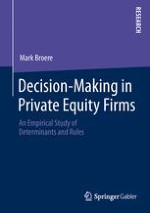2014 | OriginalPaper | Buchkapitel
3. Objectives and Minimum Return Requirements
verfasst von : Mark Broere
Erschienen in: Decision-Making in Private Equity Firms
Verlag: Springer Fachmedien Wiesbaden
Aktivieren Sie unsere intelligente Suche, um passende Fachinhalte oder Patente zu finden.
Wählen Sie Textabschnitte aus um mit Künstlicher Intelligenz passenden Patente zu finden. powered by
Markieren Sie Textabschnitte, um KI-gestützt weitere passende Inhalte zu finden. powered by
